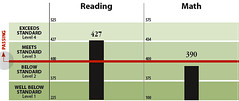Click on the title above for a humorous video in which New York Times columnist David Pogue explains that Windows Vista isn't a copy of Mac OS X.
Friday, December 29, 2006
Tuesday, December 19, 2006
Storm Aftermath 2
Posted by
Michael Stiber
|
12/19/2006 12:23:00 PM
|
6
comments
|
![]()
Labels: photos
Monday, December 18, 2006
Storm Aftermath 1
Posted by
Michael Stiber
|
12/18/2006 11:17:00 AM
|
0
comments
|
![]()
Labels: photos
Thursday, December 14, 2006
Spam choking the internet again
The title links to a New Scientist article about spam. Yes, the volume of spam just about doubled again this past year, and makes up 91% of all email. Is this merely a realization of Sturgeon's Law?
What bothers me is the "again" part of the headline. This implies that there was at least some short interval during which people thought that spam was in some small way "solved," or at least not so important. But I don't see any evidence for that. What we have is an arms race between spammers and spam filters, and there's no reason that the spammers won't be able to stay ahead of the filters. Take image spam. People are actually working on spam filters that incorporate image analysis to try to determine whether the images in emails are spam or not. This is ludicrous! Do we really need to incorporate CPU-hogging image processing into our email programs (I did a fair amount of computer vision research in grad school, so I have an idea of the computational requirements)? Considering the difficulty of solving the problem of computer vision, this is an arena in which the spammers will beat filters' brains out for years -- decades even -- to come. I finally just wrote a rule in my email program that automatically junks email that only contains images.
And this is all besides the point, to me. Considering the content of some of the spam I get (even the subject lines), I wouldn't let my daughters have email accounts until they're 30. To me, that's the biggest danger of spam: not the massive waste of computational and network resources, but that it renders email practically unusable for a big segment of society.
Posted by
Michael Stiber
|
12/14/2006 08:05:00 AM
|
3
comments
|
![]()
Tuesday, December 12, 2006
Holiday tipping etiquette
I Google so you don't have to.
Posted by
Michael Stiber
|
12/12/2006 08:04:00 AM
|
0
comments
|
![]()
Monday, December 11, 2006
Two sites suffice
After a week of my musings on interdisciplinarity producing no Google hits for the term "exodisciplinarity", this post on my blog produced immediate results. "Exodisciplinarity" now produces a single hit on Google. (Of course, I understand that their algorithm is more sophisticated than that.)
I wonder what that implies for monetizing this blog?
Posted by
Michael Stiber
|
12/11/2006 08:13:00 AM
|
0
comments
|
![]()
Sunday, December 10, 2006
A pointless experiment
I got curious about how little "significance" a web page can have and still get indexed by Google. In this case, I merely defining significance as being number of links to that page. So, I wrote a few thoughts about interdisciplinarity in my academic web a week ago, noting that the term "exodisciplinarity" returns no Google hits. The only link to that page is from my home page. A week later, still no hits for "exodisciplinarity". So let's see if the link (and mention of the term) in this blog post, being on another web site, will suffice.
And, in case you think the term is silly, do you really think that "pluridisciplinarity" merits 821 hits?
Posted by
Michael Stiber
|
12/10/2006 12:45:00 PM
|
0
comments
|
![]()
Saturday, December 09, 2006
More about student podcasting
Adrian comments (link from title) on my musing about incorporating podcasting into my classes. He has a very good point:
I have a ’sustainable teaching’ rule. Which is that if the use of a technology, or methodology, leads to more assessment or teaching load, then it probably isn’t a good idea... Rather than have students interview me, I’d get a group, let’s say four, to do research around idea n, and they are to then have a structured conversation about the idea.Too often I (and perhaps others?) tend to think of teaching as me, rather than the students, doing something. That is clearly not the case. Like anything else, we only have so much time we will devote to teaching; more time on X means less time on Y. For those of us making the transition from "old style" teaching to newer approaches, the change in viewpoint involves spending more time in course, assignment, project, infrastructure, etc. development and less time as the center of in-class attention.
On the legal front, it appears that posting podcasts so that they are accessible by individuals outside the classroom may be problematic. The solution I've found is authentication supported by UW's web servers (access lists are updated nightly by the Registrar's office) and the rss2html.php script to generate an HTML view of the podcast feed (since podcatching clients won't be able to subscribe to the restricted-access feed).
Posted by
Michael Stiber
|
12/09/2006 12:25:00 PM
|
0
comments
|
![]()
Labels: multimedia, teaching, technology
What I learned about bicycle commuting this week
1. You don't want to take a turn at 20 miles/hour when there's still sand on the road from a recent snow.
2. Plain gauze bandages get embedded in newly-formed scabs.
Posted by
Michael Stiber
|
12/09/2006 11:54:00 AM
|
0
comments
|
![]()
Labels: bicycling
Tuesday, November 28, 2006
Ihnatko: the loony Zune
(Yes, it's a snow day here, and I'm working on the tail end of what might be URI #4 of the season.)
The title above links to a Chicago Sun-Times review by Andy Ihnatko of Microsoft's new Zune device. Summary: Zune isn't just not user-friendly; it's user-hostile. Here are some choice quotes:
The Zune is a square wheel, a product that's so absurd and so obviously immune to success that it evokes something akin to a sense of pity...
The setup process stands among the very worst experiences I've ever had with digital music players...
And why (for the love of God) doesn't it support podcasts? That's pure insanity...
Oh, and the Zune Marketplace doesn't even take real money, proving that on the Zune Planet there's no operation so simple that it can't be turned into a confusing ordeal...
You'll find that the Zune Planet orbits the music industry's Bizarro World, where users aren't allowed to do anything that isn't in the industry's direct interests.
Update: Here's an almost as scathing review from a Windows-dedicated web site.
Posted by
Michael Stiber
|
11/28/2006 11:30:00 AM
|
0
comments
|
![]()
Acephalous: Measuring The Speed of Meme
Acephalous is doing an experiment to see how fast a "meme" can travel through the blogosphere. If you're reading this (and have a blog), link to the post I've linked from the title above and ping Technorati.
Posted by
Michael Stiber
|
11/28/2006 10:49:00 AM
|
0
comments
|
![]()
Tuesday, November 21, 2006
Academic podcasting
I've been interested for a while now in how "distance learning" technology could be used for something a bit more inventive and valuable than just a hyperlinked textbook, self-grading exercises, and canned lectures. Adrian Miles at vlog 3.0 has an interesting post (linked from title above) about educational podcasting, or "profcasting": use an interview, or conversational, model. I like this; one of my favorite podcasts is In Our Time, from BBC Radio 4.
I suppose I could require each student in a class to prepare for and conduct a high-quality interview of me, or do small-group conversations, on a specific topic in the course. I'd of course have to get everyone's written agreement to use recordings beyond the classroom (i.e., non-commercial distribution rights). OK, time to contact the university lawyers (or get someone else to contact them...).
Topics: academia, podcasting.
Posted by
Michael Stiber
|
11/21/2006 05:29:00 PM
|
0
comments
|
![]()
Labels: teaching, technology
Thursday, November 16, 2006
My alma mater
Yes, the UCLA police repeatedly tasered a UCLA student who forgot his student ID and was a little too slow leaving Powell Library. I used to think that cameras and video capability were superfluous on a cell phone, but this YouTube video has convinced me otherwise. The statement from Acting Chancellor Norman Abrams is noncomittal, as might be expected at this stage. But there should be a policy preventing the use of force, not to mention weapons, when police are not themselves threatened.
Watch the video. A nice touch is when an officer threatens to tase a bystander asking for his badge number.
I'll be sending a letter to Chancellor Abrams today. Other UCLA alumni might consider doing the same, or emailing him at chancellor@conet.ucla.edu.
Update: Here's a May 2005 GAO report on the use of tasers by law enforcement, including policies in selected departments. Referring to Figure 3 on page 8, I would classify the student's actions as "Resistant (passive)," which at almost all of the cited departments would not justify the use of a taser.
Update 2: Apparently, the UCPD's meritorious service award is called the Taser Award.
Posted by
Michael Stiber
|
11/16/2006 02:29:00 PM
|
0
comments
|
![]()
Labels: academia
Wednesday, November 15, 2006
Sick day blogging
Upper respiratory infection #2 (since this is the Pacific Northwest, I suppose these should be numbered, rather than named) is blowing through the community and our household, just when I thought I was getting over the first one (I was at the "coughing so much I think I jarred my brain loose" stage). A perfect accompaniment to a dark, overcast, rainy day among a long sequence of such days. So, lacking the energy or mental firepower for complex activities, let's see what's happening in Academia, Blogland:
- In Knowing and Doing: When Opportunity Knocks, Eugene Wallingford writes about making CS assignments more interesting and relevant to the real world by being more open to opportunities to do cool, fun stuff in class.
- Michael Bérubé says "I got plenty of nothin'", but I respectfully disagree. What he has is a great post on the value of academic blogs for showing what academics do.
- Love blooms for FemaleCSGradStudent in a seemingly unlikely place.
Posted by
Michael Stiber
|
11/15/2006 08:05:00 PM
|
0
comments
|
![]()
Labels: academia
Sunday, November 12, 2006
"79 points actually cost 99 cents"
The title above links to a Wall Street Journal review of Microsoft's new Zune player and music store by Walt Mossberg. What struck me was that store customers must pre-pay, buying points which they then in turn use to purchase songs. And songs cost 79 points, which is equivalent to 99 cents. Exactly why did Microsoft choose an "exchange rate" (99/79) that produces a fraction that doesn't repeat until the 14th decimal place? OK, it's true that 79/99 repeats at the third decimal place. Will Microsoft round the number of points up to the nearest point when customers invariably pre-pay with a whole number of dollars? I assume that this is a mechanism for them to decouple song pricing from their payment system; maybe they think that people will view songs as being cheaper than they are because the number of points is less than the number of cents? I would suggest instead that they use an exchange rate similar to what used to exist between the dollar and the Italian Lira: seeing all those zeros (with, say, 7900 points for a song) will make it seem much more like paying with "play money".
Too bad that they need to get the customer to deposit real money to start.
Posted by
Michael Stiber
|
11/12/2006 05:12:00 PM
|
1 comments
|
![]()
Labels: Microsoft
Saturday, November 04, 2006
The price paid for wasted cycles
The title above links to a Linux World article on the One Laptop Per Child (OLPC) project. That project aims to produce a laptop that is cheap enough to make its way into the hands of schoolchildren around the world. the biggest obstacle is the insatiable need for computer cycles by today's software. As I've written before, a large chunk of these cycles -- if not most -- are burned to make software more profitable for software companies, not to benefit the user.
The OLPC people seem to agree with me:
Today's laptops have become obese. Two-thirds of their software is used to manage the other third, which mostly does the same functions nine different ways.
OLPC FAQ
Fast processors and inexpensive memory have made tidy programming a low priority, Gettys [Jim Gettys, vice president, Software Engineering] said. "A lot of people in the past decade or so have gotten quite sloppy."
Posted by
Michael Stiber
|
11/04/2006 03:15:00 PM
|
0
comments
|
![]()
Labels: profession, software
Change in the weather
With November comes wet and cold (well, at least coolness) here in the Seattle area. Time to pull the last of the dead tomato plants and dahlias, put some collard green plants in, and watch the fava bean seedlings come up.
Posted by
Michael Stiber
|
11/04/2006 02:56:00 PM
|
0
comments
|
![]()
Labels: gardening
Thursday, November 02, 2006
My Erdös number is at most 5
Daniel Lemire sparked my interest in finding this out. The link above is to a page under the Erdös Number Project. Paul Erdös was a prolific mathematician, and an Erdös number is the number of "degrees of separation" one is away from him. As that site says, the vast majority of mathematicians have an Erdös number less than eight. So, one of his co-authors has an Erdös number of 1, a co-author of a co-author has an Erdös number of 2, etc. See this Wikipedia entry for more. You can use MathSciNet to help you computer your Erdös number, but as it focuses on mathematics publications, it only gives an upper bound (for instance, it gives me an Erdös number of 6, but one of the folks along the pathway, listed as a co-author of my PhD advisor, is also one of my co-authors). I can actually trace multiple paths of length 5 to Paul Erdös. And I don't consider myself a mathematician; I just hang out with the wrong people.
Posted by
Michael Stiber
|
11/02/2006 05:32:00 PM
|
0
comments
|
![]()
Labels: academia
Monday, October 30, 2006
Voting should not be a black box affair
The cliche goes, "When all you have is a hammer, everything looks like a nail". As computer professionals, that means that every problem tends to give us an itch to develop a computer-based solution. This is unfortunate, part of an educational process that emphasizes programming skills, technology, and narrow theory over problem solving. When we're confronted with a problem or process, we first need to concentrate on really understanding the existing situation. What is the current goal? What is the problem? Who are the stakeholders? What aspects of the system are important to the different stakeholders? Only then can we take the first step in solving the problem: identifying the appropriate range of solutions, which may not involve computer technology.
A case in point is our elections system. The problems with electronic voting systems are so rampant that I'll not even bother to link to articles on the web. What are their advantages? According to Wikipedia (not that that's the final source on this matter), the primary advantages of electronic voting systems are saved paper, easier accessibility for people with disabilities, and the possibility of faster counting. Wikipedia also mentions the possibility of cryptographic verification, but so few people understand what that is -- likely, many computer professionals don't -- that I wouldn't consider it a practical advantage. After all, how can you expect someone to consider their vote "verified" if they don't understand the verification process? Verification then becomes another word for "trust us; we're experts" or "the magic box says that everything is fine". There's only one problem with any of the above advantages: they have nothing to do with the most important problems of paper ballots.
A recent talk at my school by Bev Harris, founder of Black Box Voting, I think very clearly pointed out the fallacy of a technological fix to the problems of paper ballots. Ms. Harris is not a technologist, and it behooves us to listen carefully to what people like her have to say. She spent much of her talk discussing one horror story after another related to electronic voting systems: conflicts of interest (putting it in the best light possible) with candidates owning interest in companies that manufacture the machines that count their ballots, lax software development security allowing anyone to access -- or even modify -- voting machine software via the Internet, software with back doors, hardware that allows anyone with a little knowledge to pre-load bogus voting information, etc. Other than ownership of electronic voting equipment manufacturers by governments considered unfriendly, these issues curiously don't seem to concern incumbent politicians that much.
And then she made what was to me an eye-opening statement (which I'll paraphrase because I didn't write it down at the time). The problem with electronic voting systems is that they, on the one hand, lack transparency, and thus make it more difficult to detect fraud, and on the other hand, reduce the number of people needed to commit a fraud. The lack of transparency arises in two ways: only a few people observe even part of the process (much of it is automated, and thus completely unobserved) and only a few people have the expertise to understand the different ways the count could go wrong. Electronic voting systems also make fraud easier, by reducing the number of people who need to be "in the know".
The most important attribute of any voting system is that its users -- the general population -- have confidence in its integrity. All other considerations are secondary. Even the presence of fraud is secondary, because confidence can only flow from ease of true verification, which by definition makes it likely that fraud will be detected. I would assert that electronic voting systems can never engender as much public confidence as paper ballots. Any proposed solution to voting problems must take this into account. That's why I'm especially impressed with Black Box Voting's Citizen's Tool Kit, which empowers "ordinary people" to oversee how their votes are counted, to demand that all methods see the light of day, and to generally make themselves a pain in the rear of anyone in government who would rather that the unwashed masses leave the process to the "professionals".
Some problems do not have technological solutions.
Topics: politics, voting, elections, computer security.
Posted by
Michael Stiber
|
10/30/2006 08:15:00 PM
|
0
comments
|
![]()
Wednesday, October 18, 2006
Vanity press
Those WMSCI ("World Multi-Conference on Systemics, Cybernetics and Informatics") people seem to be at it early this year, with their solicitations for submissions to their curious conference. Click the title above to learn more about how to save money, your reputation, and put your work in a more useful venue. If you want to feed your vanity, start a blog like everyone else!
Posted by
Michael Stiber
|
10/18/2006 08:30:00 PM
|
0
comments
|
![]()
Labels: academia
Which American President Are You Most Similar To?
Via Living the Scientific Life, the President I'm most like:
| You Are Most Like John F. Kennedy |
 |
Posted by
Michael Stiber
|
10/18/2006 08:01:00 PM
|
0
comments
|
![]()
Studicious
No, it has nothing to do with Congressional Pages. Via Brad DeLong's Semi-Daily Journal comes a early version of a web site (linked from the title above) that allows user to enter and share class notes. It's an interesting idea, and it makes me wonder about the possible uses of collective note-taking. A substitute for taking -- and rewriting, with refinements, while studying -- notes it is not.
Posted by
Michael Stiber
|
10/18/2006 07:26:00 PM
|
0
comments
|
![]()
Labels: academia
Monday, October 09, 2006
Neat mapping tool
I ran across Gmaps Pedometer as a way to measure the length of my bicycle commute from home to work (via bikejournal.com. It combines the Google Maps interface with the ability to double-click on the map to set markers for your route. It also includes the ability to show an elevation profile of your route. So now I know that I have a 20% hill climb near the end of my ride back home (200ft. elevation gain in 1000ft of cycling).
Posted by
Michael Stiber
|
10/09/2006 07:57:00 PM
|
0
comments
|
![]()
Sunday, September 24, 2006
State testers fail math
But that's not the topic of this post. Instead, I'd like you to look at the sample bar chart, taken from this annotated example. It's not too dissimilar from what we received for our daughter, except for details such as her scores and comparisons with her school, school district, and state averages.
Look at the vertical scale for this bar chart. The first thing we notice is that the Y axis doesn't start at zero, yet there is no indication in the bars that their bottoms are cut off. Maybe we could dismiss this; perhaps the purpose of this graph is to show differences (more obvious in what we got, which has multiple bars). But look at the numbers on the Y axis: each of the four categories takes up the same space on the axis, even though their ranges vary widely, from a minimum of 25 to a maximum of 275!
In other words, the vertical scale provides no useful information, and in fact is misleading in implying that all four categories have similar ranges. Not only that, but by sharing ranges between reading and math, the fact that the ranges for the same categories differ is obscured.
So, the heights of the bars are meaningless. Bars with tops in different categories cannot be compared because of the nonlinear scaling. Bars in different tests cannot be compared. About the only information conveyed by this graph is the category that the student in question's score fell within, and possibly the relative position within that category. This begs the question: if the folks who design the WASL report can produce such a bad graph, how confident can one be in the rest of the testing and scoring process?
Topics: education, testing.
Posted by
Michael Stiber
|
9/24/2006 11:09:00 AM
|
0
comments
|
![]()
Monday, September 18, 2006
Travel photo of the week
In China, caves are used to tell stories, like you might do when looking up at the clouds. Tours focus on historical and mythological figures and events, as if the rock formations were dioramas. Alternatively, areas are lit up like a light show. The cave experience becomes a cultural one.
Posted by
Michael Stiber
|
9/18/2006 11:46:00 PM
|
0
comments
|
![]()
Friday, September 08, 2006
Bicycle commuting
There comes a time in everyone's life when you must decide: exercise or start saving for coronary bypass surgery. I've been running more, but sometimes things are just too busy for me to fit a run in. That, plus my previously-voiced frustration over the lack of progress in car fuel efficiency by automakers (despite existing modifications that can yield 100 miles/gallon), led me to think seriously about bicycling commuting.
I've ridden to work before, and do so when the weather is nice: one way. After work, my wife would then pick me and the bike up. The main reason for this is that we live at the top of one of the (if not the) tallest hills in the area. I decided that I would see if I could ride up, so that I could commute both ways by bike, and in fact it seemed feasible when I tried. I'm in OK shape, but from running, not biking, and only had to walk two half blocks (the steepest parts of the route -- steep enough that you might wonder if your car can make it). This leads me to believe that I'll be able to do the climb without stopping one day, and it's always nice to have a goal to shoot for.
Next comes the strategy to avoid procrastination and backsliding ("I'm a bit tired today; I'll bike in tomorrow," where tomorrows eventually become months). Part of this involves buying equipment to set my bike up properly. I've got a 7 or 8 year old Raleigh R300 touring road bike; I outfitted it with fenders, added a flashing tail light, and am in the process of getting a good, bright headlight (I already had a rear rack and panniers). I also bought tools (I used to do all my bike maintenance, but got rid of all my tools after grad school). Now if I don't commute, I'll feel like I wasted all that money. I also estimate that we'll be saving about $20/week on gas (the commute is a bit over 5 miles, one way, we only own one car -- an all-wheel-drive Dodge Grand Caravan -- so my wife often drops me off at work in the morning and makes another trip in the evening to pick me up; it adds up). I get about an hour or so of exercise per day, broken into two parts each of which increases my metabolism for an extended period of time afterwards.
I found an enormous number of bicycle commuting resources on the web. I'll just point out one: Paul Dorn's Bike Commuting Tips.
P.S. If you're biking home from work and it's uphill all the way, eat a snack beforehand.
Topics: bicycling, transportation, environment, exercise.
Posted by
Michael Stiber
|
9/08/2006 04:51:00 PM
|
0
comments
|
![]()
Thursday, September 07, 2006
On the value of computers for primary education
Daniel Lemire commented on a previous post of mine, and I thought I had an elaboration that merited a post, rather than burial in a comments thread. I had written that computers could be useful as tools in primary school, but not as objects of study themselves. He suggested a parallelism with pencils, etc., and yes, those other things are tools, too. But, while those are necessary, I don't believe that computers are necessary tools. Potentially useful, yes, but kids can learn the same things without computers. Here's a quote by Alan Kay from "Revealing the Elephant: The Uses and Misuses of Computers in Education":
Suppose it were music the nation is concerned about. Our parents are worried that their children won't succeed in life unless they are musicians. Our musical test scores are the lowest in the world. After much hue and cry, Congress comes up with a technological solution: 'By the year 2000 we will put a piano in every classroom! But there are no funds to hire musicians, so we will retrain the existing teachers for two weeks every summer. That should solve the problem!' But we know that nothing much will happen here, because as any musician will tell you, the music is not in the piano!
Posted by
Michael Stiber
|
9/07/2006 09:18:00 AM
|
1 comments
|
![]()
Wednesday, September 06, 2006
Garden photo of the week
Posted by
Michael Stiber
|
9/06/2006 08:57:00 AM
|
0
comments
|
![]()
Labels: gardening
Tuesday, September 05, 2006
A computer for young children
So, clearly the AlphaSmart is fairly basic. The newer models are fancier, but as you can see from the web site, they are still limited, they run a proprietary OS that requires the purchase of additional software from the manufacturer, and they cost $400! Given the recent project to develop a $100 laptop for education, this seems excessive.
What does a young child need in a laptop? She needs durability (so no hard drive or thin lid with large display), reasonable battery life (so no hard drive), simplicity (so the OS needs to be hidden), a keyboard (no palmtops), and basic connectivity. It occurred to me that all of these things were features of my old Newton MessagePad 2100, except for the keyboard. But there was another machine using the Newton OS: the eMate. And the eMate fits this task perfectly, including the simplicity and power of an OS that is still unmatched today. This includes instant on, no need to explicitly save documents, the ability to install additional software, non-volatile memory (so there's no danger of you ever losing a file, unless you delete it), stylus and keyboard, etc., etc. Others have commented on using the eMate as a child's computer. You can get an eMate on eBay for less than $30, including shipping costs, which is a nice feature, too. The only question was: could I get it to work with today's computers?
Power
Some of the eMates on sale on eBay will have power
supplies and some
won't. The one I bought didn't; a Radio Shack 3-7.5V, 2A digital camera
power supply (catalog number 273-1696) works fine. Though nominally
the eMate requires 7.5V (the original power supply was rated 7.5V,
1.2A), I found that the eMate complained about 7.5V but was happy
with the power supply set to 7V.
Batteries are another matter. Odds are, the eMate you buy will have an original NiMH battery pack that doesn't hold much of a charge. You can either replace the cells in the batter pack or replace the battery pack with a holder for 4 AA batteries. As of this writing, I'm planning to do the latter.
USB Interface
The eMate has a built-in serial connector. I had a Keyspan USA-19Qi serial to USB adapter from an old Palm that I'm no longer using. However, the eMate's serial port uses a Apple mini DIN-8 connector, while the Keyspan uses a PC style DB9 connector. I had some Apple style and PC style cables and was able to make a DIN-8 to DB9 cable, given some information about the pinouts of the two ports. No doubt, I could have bought something somewhere, but I had the hardware and expertise to do it.
Mac OS X Software
Here you're in luck, as there is a (somewhat) active developer community out there for the Newton OS (which says something about the hardware's longevity). The software I chose is NewtSync, which aspires to be an iSync-like program for the Newton. It requires software on the eMate side, too, which can be installed using the NewTen package installer. With the TextSync plugin, my daughter can write papers using the eMate Notes program and then sync the notes to a Mac running OS X. Works like a charm. With other plugins, a Newton can be a perfectly usable PDA.
Posted by
Michael Stiber
|
9/05/2006 06:35:00 PM
|
2
comments
|
![]()
Tuesday, August 29, 2006
Getting things done
I reached my limit this summer: too many things to do, too many emails in my inbox, too many meetings (I'm now Vice Chair of our faculty organization; basically the campus senate), and too many things not getting done. And this is summer; it will only get worse as the school year starts. So, thanks to Merlin Mann's 43 Folders web site, I got turned on to Getting Things Done: The Art of Stress-Free Productivity, by David Allen. The author's methods are great for me, focusing on workflow practices that can support better productivity. More than just being productivity focused, Allen emphasizes practices that remove stress from one's life, by removing the need to remember all the little things you need to do (it's all in the workflow system) and allowing you to determine what you can't do (thus removing them from your system and out of mind). His approach builds in the idea of context: labeling each task by the location or work mode in which it can be done, so you're never looking at tasks that aren't possible to do right now. I'm still in the process of grinding through my many piles and files for tasks to enter into the system, but I highly recommend this book.
One thing that has helped me implement this approach has been some very useful software. You can look through Merlin Mann's web site, or the lifehacker web site, for the tools that fit you best. I've found three tools that work for me:
- I like simplicity, portability, and universality. That's one of the reasons I like LaTeX for writing: all of my files are plain text and so I never have to worry about having stuff trapped into obsolete or incompatible formats. That's why I love the todo.txt software, which manages plain-text task lists. There's an increasing amount of community-contributed software that provides various capabilities, including my own software for managing lists of project-related tasks.
- GeekTool lets me put the output of various todo.txt programs on my desktop; it also allows me to quickly switch the display for different work contexts.
- A great app that implements a "tickler" system in Apple's Mail program is GTDMail. It is an Applescript that creates a set of tickler folders: one for each day over the next month and one for each month of the year. You set up iCal to run the script each morning, and it moves the items from today's folder(s) (the current date and the current month) to a "@INBOX" folder. I modified the target folder to "@ACTION" and added "@READ-REVIEW" and "@WAITING FOR" folders. So now I can process all of my emails within seconds according to Allen's workflow.
I feel better already.
Topics: personal productivity, book review, organization, software.
Posted by
Michael Stiber
|
8/29/2006 05:57:00 PM
|
0
comments
|
![]()
Saturday, August 26, 2006
Astrologers rescue Pluto
I can't tell you how happy I was to see the front page article linked from the title above in today's Seattle Times. However, I was able to express myself to the newspaper's editors:
To the Editor:Thank you very much for your much-needed front page injection of superstition and ignorance into the scientific debate over the modern definition of the word "planet" ("Boot Pluto? Astrology's dismay off the charts", Saturday, August 26, 2006). The sidebar listing astrology "facts" was an especially nice touch. What's next? Reaction from bloodletters on the latest cancer treatments? You do your profession proud!
Sincerely,
Michael Stiber
Posted by
Michael Stiber
|
8/26/2006 01:59:00 PM
|
0
comments
|
![]()
Thursday, August 24, 2006
US Department of Education vanishes evolution
The title above links to a New York Times article describing how a US Dept. of Education grant program in which evolutionary biology is conspicuously missing. You can look at the document in question here; evolutionary biology should be CIP code 26.1303 on page 7. Instead, there is a blank line. DOE spokespeople are saying that it was a clerical error. The interesting thing is that there are some places in the document (such as where evolutionary biology should be) where a number is skipped and there is a blank line, and there are some places where a number is skipped and there is no blank line. It appears that, in the latter case, the skipped CIP codes don't exist, while the blank lines in the former case indicate that a CIP code was purposefully deleted (though there are some blank lines where there is no CIP code). There are only two blank lines that correspond to deleted codes: 26.0908 (Exercise Physiology) and 26.1303 (Evolutionary Biology). (You can look up CIP codes here.) If we assume that these edits both were done in the same fashion, then this would seem to support the idea that evolutionary biology was purposefully, not accidentally, deleted. Topics: evolution,creationism,politics.
Posted by
Michael Stiber
|
8/24/2006 12:46:00 AM
|
0
comments
|
![]()
Wednesday, August 16, 2006
Travel photo of the week
Posted by
Michael Stiber
|
8/16/2006 12:31:00 AM
|
0
comments
|
![]()
Tuesday, August 08, 2006
$4 per gallon
I've listened to oil company folks try to explain that their recent obscene profits were a result of high oil prices, and that the high oil prices result in high gas prices. Now, it might make sense that high oil prices produce high consumer prices for refined products. But, in every other manufacturing industry, when the price of raw materials goes up, profits get squeezed. Why isn't that the case in the oil industry? Because they also produce the raw materials, that's why. Now, with Alaska production shutting down, they're talking about $4 per gallon gasoline on the west coast. I wouldn't be surprised to see $4 per gallon nationwide by the end of the year. And even higher profits for the oil industry. Meanwhile, George and Dick and their industry pals are laughing their asses off.
The price of gas doesn't bother me all that much by itself; I don't have a long commute, and bike in good weather. What pisses me off is that there is no alternative to burning gasoline. A plug-in electric car would make sense for my family as a second car; it would allow us to cut down on fuel consumption. But there is no practical, plug-in electric available. Commuter Cars Corporation sells in interesting kit car, called the "Tango", but it costs $108,000! DaimlerChrysler sells prettified golf carts. Mitsubishi and Subaru are talking about maybe a 2010 model year introduction. Anyone want to guess what gas will cost then?
Posted by
Michael Stiber
|
8/08/2006 01:00:00 AM
|
0
comments
|
![]()
Saturday, August 05, 2006
Rosa 'Climbing Iceberg'
Posted by
Michael Stiber
|
8/05/2006 05:36:00 PM
|
0
comments
|
![]()
Labels: gardening
Friday, August 04, 2006
Funny comment
Linked from above, this comment to the Engadget article on rumors of an Apple iPhone is hilarious:
Even Apple rumors have a better function and design than Microsoft.
Posted by
Michael Stiber
|
8/04/2006 10:38:00 AM
|
0
comments
|
![]()
Monday, July 31, 2006
Letter to the Editor, published
Click on the link above and scroll down to see my letter, as published in the Seattle Post-Intelligencer.
Posted by
Michael Stiber
|
7/31/2006 12:09:00 AM
|
0
comments
|
![]()
Friday, July 28, 2006
Travel and garden photo of the week
Posted by
Michael Stiber
|
7/28/2006 10:04:00 AM
|
0
comments
|
![]()
Labels: gardening
Tuesday, July 25, 2006
Letter to the Editor
I read the above-linked opinion piece in the Sunday Seattle Times/Post-Intelligencer and it inspired the following letter to the Editor, which apparently is in the running for publication:
To the Editor,Robert Fisk's 7/23/06 opinion piece ("The Empire Leaves Beirut to Burn") illustrates well the bigotry and anti-semitism currently running rampant in Britain. He states that we should feel sympathy for the Lebanese not because they are fellow human beings but because they "look like us," "have light-colored skin," and "speak beautiful English and French." Does he imply that his non-light-skinned readers should feel no sympathy? Or shall we jump to the conclusion that dark-skinned or non-European-language-speakers are unworthy of sympathy?
This mindset is then extended to the current conflict between Israel and Hezbollah. Israelis (perhaps not as fair or well-spoken as the Lebanese?) are engaging in "some of their cruelest attacks". To Mr. Fisk, the conflict is like that of a soccer match, and he cites a lopsided death toll to support his idea that Israel is in the wrong. It's easy to allow one's prejudices to obscure the facts: that the Israelis are the ones who are defending themselves and that the plight of the Lebanese is the familiar one of people living in a country with no effective government. Maybe Mr. Fisk has lived in Beirut a bit too long, and would benefit from travel to places with less attractive and well-spoken populations.
Posted by
Michael Stiber
|
7/25/2006 02:56:00 PM
|
1 comments
|
![]()
Wednesday, July 19, 2006
A trip to China, part 4: traffic (or when local optimization doesn't produce global optimization)
Luckily, I keep independent copies of almost everything I do. Here is the lost fourth installment of my China travel diary.
Riding in a car in Guangzhou is both a frightening and a hopeful experience. I admit there are times when I have had to close my eyes (when riding as a passenger). However, this is still a noticable improvement from even four years ago. Then, the attitude among drivers towards lane markings was probably best summarized as, "What's a lane?" Now, if there's not much traffic, drivers will actually stay in a lane much of the time. When there's not much traffic.
When there is, it's every driver for themselves. Folks will squeeze their cars in between existing lines of moving cars, turning two-lane roads into three or four lane ones. They change lanes regardless of the presence or absence of neighboring cars, trucks, or buses. The make right turns right into moving traffic, and left turns into oncoming traffic, slowly working their way right, dodging oncoming cars until they reach the right side of the road. At first glance, it's amazing that there aren't more accidents. The you realize two things:
- accidents are often caused by drivers doing unexpected things and people expect the above behavior, and
- nobody is driving very fast -- speeds rarely exceed 35kph.
Sometimes this works: witness greedy algorithms. But, as Guangzhou traffic shows, this is not always the case. As American and other drivers have learned, sometimes it's better to stay in your lane, rather than cut someone off in a neighboring one. The result is smoother flowing traffic and faster trips for everyone.
Meanwhile, I ponder problems associated with traffic simulation to help keep my mind off the two buses to our right and left that are both merging into our lane...
Posted by
Michael Stiber
|
7/19/2006 08:48:00 PM
|
0
comments
|
![]()
Monday, July 17, 2006
Garden photo of the week
Posted by
Michael Stiber
|
7/17/2006 07:43:00 PM
|
0
comments
|
![]()
Labels: gardening
Sunday, July 16, 2006
A trip to China, part 5: The journey home
It seems blogger lost most of the fourth part of my travel blogging, so while I see if I can remember what I wrote, I have a couple comments on my return trip.
- As you might expect, I saw a bunch of movies on the airplane. One that stood out was "Kinky Boots". It stars Chiwetel Ejiofor, who you may remember as The Operative in Serenity. This is a very different role, in which he plays a drag queen with a stage name of Lola. I hadn't heard of the movie before, and it was a pleasant surprise.
- You know that you're back in the presence of Americans when you see your first morbidly obese person.
Posted by
Michael Stiber
|
7/16/2006 03:36:00 PM
|
0
comments
|
![]()
Monday, July 10, 2006
A trip to China, part 3: the price of (everything but) tea
It's really interesting to walk around a Chinese city and look at how much things cost. I think you can learn a lot about the economics of various industries: how efficiently they deliver their products to the consumer, how much price competition there is, etc.
For example, take electronics. Check out the back of your computer, your iPod, your DVD player, and chances are it is made in China. Logically, then, prices should be lower here where it is made, now that they are widely available here without restriction. But that's not the case. For example, cheap Chinese-brand DVD players (which quite possibly have internals that are also used in Japanese-brand ones, but which definitely are less sturdily made) start off at around US$30 or so: the same as low-end DVD players in the US. And that's after all of the cost getting the product to the US and the markups made by importers and retailers. My guess is, like clothing manufacturers, the electronics manufacturers here don't make much money selling overseas, instead relying on a home market to make their profit.
[As an aside, it's amazing the variety of products that don't reach the US. Many (like iPod lookalikes) probably never get out of China. The other interesting thing is the products you can't get in China. Most people don't have carpets, yet simple stick vacuum cleaners are nonexistent and little motorized brush sweepers made by Philips sell for almost US$100. And don't bother looking for a VCR; most people here won't know what you're talking about, or will point you to a mini-DV camcorder.]
The other major commodity that springs to mind as being comparable in price to the US is real estate. Actually, recent construction in Chinese metropolitan areas is more expensive than in the US. On the one hand, this might not be surprising, given China's population and economic growth rate. But then there's the other hand.
First off, even middle-class urban dwellers here earn much less than their US counterparts, and so logically shouldn't be able to afford homes as expensive as Americans (many of whom can't afford to buy real estate at curent US prices with rising interest rates). They also represent a tiny fraction of the Chinese population, so the actual number of potential buyers is probably smaller than in the US.
A second driver of high real estate prices are investors, many from overseas. In fact, many of the surburban housing developments are only about 50% occupied, despite the fact that they are 100% sold. Half the homes are purchased purely for capital gains, not even rental income. Further signs of this foreign investment are the Canadian schools near or in the developments.
So, does this amount to a bubble or is it merely a vote of confidence in the Chinese economy? I don't know, but it isn't a good thing that most Chinese professionals are priced out of the market.
Posted by
Michael Stiber
|
7/10/2006 11:50:00 PM
|
0
comments
|
![]()
Thursday, July 06, 2006
A trip to China, part 2: where your clothing comes from
I made a side trip to a city near Guangzhou that is filled with approximately 2000 factories making clothing and visited one smallish factory. The common view of such places is that of a sweatshop and, believe me, in the hot, humid weather of southeastern China, there certainly was a lot of sweat. Most of the sweat was probably from me, though, since as a resident of the Seattle area, I'm not used to a climate more similar to the US deep south. So, what were working conditions like? Un-airconditioned, to be sure, but frankly the same could be said of most non-upscale workplaces, especially outside of Guangzhou. Safety was probably not up to US code, but then again was probably above local code, if there is any. There are closed-circuit cameras on the work floors, but the owners don't spend much time actually looking at the workers via TV -- it's more important for them to be seen on the work floors in person.
In many ways, the factory was like many medium-sized, family-run businesses in the US. The owners are around most of the time. When deadlines loom, they put in very long hours, and generally work longer hours than their employees. And they're not getting rich (I'd say, upper middle class for China, a similar lifestyle to their American counterparts). For example, the profit on a pair of jeans is US$0.25 to US$0.50. And this factory specializes in higher-end, lower-volume products. The big factories (ones that turn out a million pairs of jeans a month) make half that.
The workers aren't getting rich, either, but I don't think they're being taken advantage of. They get room and board (required by the government) and a pay that tops out at around US$100/month. Yes, it's not pleasant work and the living conditions are not good, but it's better than living and working in the countryside. It's probably a better situation than clothing manufacturing in the US at the turn of the 20th century (which isn't saying much).
So, who's making all the money? Well, let me tell you a little story. You see, the factories in this city generally don't sell direct to the clothing companies like Levi Strauss. Instead, they sell to middle-men, companies headquartered in places like South Korea. These companies in turn re-label the clothing so that it shows the point of origin as being someplace else and then re-sell them to the big labels. I'd say that most of the money is made in the US or Europe, but that the middle-men take a healthy cut. The US and European companies benefit from this arrangement by being able to distance themselves from the working conditions under which their products are made.
Why do the Chinese manufacturers put up with this arrangement? Because of the intense competition among factories. Remember, there are 2000 factories, some producing up to a million pieces of clothing a month, in one Chinese town. If you won't sell to the middle-men, if you try to work around them, then there are many other companies they can buy from. There are other towns filled with factories, both in China and other countries. The message is, "Shut up and be satisfied with what you have, or we'll take it away." And companies like Levi Straus piously state that they receive every assurance from their suppliers that their products are manufactured in South Korea or whereever under good working conditions. It's like outsourcing to the mob.
Posted by
Michael Stiber
|
7/06/2006 06:08:00 PM
|
0
comments
|
![]()
Thursday, June 29, 2006
A trip to China, part 1: a change of attitude
I write this post looking out a window at a typical section of the Chinese city of Guangzhou, a city of around 7 million people in southeastern China. It's a view that could be of any city of similar size in the US, except for the abundance of construction cranes. It has been about four years since I visited China, and in some ways it seems that major psychological changes have occured. I'd say "irreversible," but of course nothing is truly irreversible if you're willing to spread enough destruction around.
Here's the change in a nutshell: an overnight train trip. Yes, the equipment has been improved, but that's not such a big deal -- the big deal was the staff working on the train. Four years ago, as they had been for many years, the conductors working on each car were lords of their domain, and as far as they were concerned, the passengers could kiss their asses if they didn't like it. For example, on one trip several years ago, my wife and I thought we had gotten lucky by being only two people in a four-person sleeper cabin. But the gentleman working on that car decided to use the empty half as his entertainment space for the trip, sitting around smoking with his friends. That was typical behavior.
Now, there are young people working on the train. Instead of learning to be petty tyrants in their down time, they IM their friends on their cell phones. This is typical behavior for their generation, easily confirmed by walking around any Chinese city. China is a young country, and this leaves me feeling optimistic about the future.
Posted by
Michael Stiber
|
6/29/2006 01:38:00 AM
|
0
comments
|
![]()
Friday, June 09, 2006
Social networking with OPML
Via Scobelizer (in an article in which he opines that podcasts aren't taking off as much as people expected because of the difficulty to find and preview them), follow the link from the title to Share Your OPML. At that site, you can up upload OPML for the RSS feed you read and/or the podcasts you listen to, then see what people who read or listen to the same things you do have in the way of feeds. Right now, you can only upload one file, so if you export two OPML files (one for podcasts and one for RSS feeds), you'll need to combine them in a text editor.
For the record, my feeds are here.
Posted by
Michael Stiber
|
6/09/2006 05:16:00 PM
|
1 comments
|
![]()
Thursday, June 08, 2006
Gaming impact factors
Via Stephen's Web and ACRLog comes a pointer to a Wall Street Journal article from the title above. The article reports that some journals are trying to boost their impact factors by asking (telling?) authors of papers to cite more articles from that journal. When a scientific journal editor says something like:
...when we edit a paper...we sometimes ask authors to ensure that the relevant literature is cited... I can state unequivocally that we do not attempt to manipulate the JTT's impact factor. For a start, I wouldn't know how to.You know that something's up. If a journal editor doesn't understand impact factors well enough to manipulate them, then who does?
I've blogged on journal rankings before. Taken out of context, impact factors don't tell much. For example, the Journal article says that an impact factor below 2 is "low". But this depends on the size of the field -- fewer researchers mean fewer citations -- not quality.
Posted by
Michael Stiber
|
6/08/2006 03:52:00 PM
|
1 comments
|
![]()
Labels: academia
Garden photo of the week
Posted by
Michael Stiber
|
6/08/2006 01:54:00 PM
|
0
comments
|
![]()
Labels: gardening
Wednesday, June 07, 2006
Carnival of the Liberals #14
Welcome one and all to the Carnival of the Liberals! This fourteenth edition is sure to be read and enjoyed by all six of my regular readers. I'm very impressed with the quality of the submissions I received, even more so when I consider that all of these writings are from the heart, not for the wallet. Some people may sneer at blogging, but I think it's remarkable that so many people over such a short time have turned to an activity like this. Picking just ten wasn't easy. I've assembled ten posts for this edition; an entirely different set might have been selected by a different host.
Please note that the next edition of Carnival of the Liberals is at The Uncredible Hallq on June 21st.
Daylight Atheism has a thoughtful essay, entitled "Memorial Day," on the meaning of Memorial Day and the tension between remembering those who fought for freedom and speaking out about the Administration's misdeeds:
This war has accomplished the uniquely paradoxical goal of removing a cruel and brutal dictator from power and simultaneously making the people of his nation far worse off than they were under his rule.
Aman Yala writes about the Haditha killings in "How Not to Win the War on Terror". Many people try to take a relativistic view of this (unless they're still denying it happened), saying that it (like Abu Ghraib) was an abberation. Does that mean a human life can be worth more or less because of the environment in which it is lived? And how is this different than the massacres committed by Saddam Hussein?
In "Taking Cohen at his word", Truth Tables examines Richard Cohen's New York Times editorial in which he attempted to show that Stephen Colbert isn't funny, especially when he's mocking President Bush. In this case, logic is applied (which I'm sure Mr. Cohen would consider as relevant as algebra).
Teenagers are told to "just say no" about sex, but that's not the same thing as actually not having sex. And who tells the truth about sex? In the teenage years, lying about sex is practically mandatory. And that's to each other; teenagers are even less honest to adults. Now there are adults telling kids that the important thing is virginity, not self-respect. Marcella Chester's post, "Virginity pledgers often dishonest about past and for good reason," at abyss2hope, says something important about valuing people.
"You have got to be kidding...Nope, not kidding", at That is so Queer..., is a story about AIDS and political meddling in a scientific conference, in particular to create "balance" on a panel about abstinence-only programs by removing scientists and installing apparatchiks and religious zealots. As Stephen Colbert says, reality has a well-known liberal bias.
"The Problem Of Mecca" is about the centrality of Mecca to Islam and the implications that has for whatever nation controls that city. Unwilling Self-Negation has a proposal to make in that regard.
I have a bit of trouble with the name, The Executioners Thong, for some reason. But "Slow motion train wrecks, mything the point" is a very good post about the disconnect between Americans' mythical views of their country and reality, one example of which is revealed in the Iraq war.
Future Geek has a true story about poverty, "Guns, Drugs, Race, and Poverty". It reminded me of when I lived in Santa Monica, and was, upon contacting the police about drug dealing in the area, advised to move (the police being primarily concerned with keeping such activity south of Wilshire Blvd).
In "Alien Invaders," RoundRock Journal presents an allegorical tale about invasive plants.
"Hey Hillary! Where you at?" is a tale of morality and video games by varkam at Neural Gourmet. Ask Hillary Clinton, and she'll tell you that a merely violent game about killing non-Christians who won't convert apparently isn't half as troublesome than one that includes sex.
Topics: carnivals, liberal, liberalism, politics.
Posted by
Michael Stiber
|
6/07/2006 12:52:00 AM
|
6
comments
|
![]()
Wednesday, May 31, 2006
Garden photo of the week
Posted by
Michael Stiber
|
5/31/2006 05:07:00 PM
|
0
comments
|
![]()
Labels: gardening
Tuesday, May 30, 2006
Call for submissions for Carnival of the Liberals
I'm hosting the Carnival of the Liberals on June 7th, so send in your submission via the web form on the CotL site, blogcarnival.com, or email to cotl-submissions@carnivaloftheliberals.com. Please send them in by midnight US Pacific Time on Monday, June 5, or else you'll have to wait two more agonizing weeks for CotL #15.
Because of the holidays, we're not defining a theme for this one. There wasn't a theme for the last one, either, so may be that's the new non-theme theme.
For more info about the carnival see the Carnival of the Liberals homepage.
Topics: carnivals, liberalism, politics, carnival of the liberals .
Posted by
Michael Stiber
|
5/30/2006 12:01:00 AM
|
0
comments
|
![]()
Friday, May 19, 2006
Spamference, spamjournal, spamreviews
Of course, any profitable economic niche will attract new business ventures. The IPSI BgD folks do the WMSCI'ers one better, with two generic domains (internetjournals.net and internetconferences.net), generic conferences (actually, VIP conferences, which are also "M+I+T++" conferences: "Multi-, Inter-, and Trans- disciplinary") held all around the world, and no less than two journals! Here, I'll concentrate on the journals, since I recently got some email about them. There are two: IPSI Transactions on Internet Research and IPSI Transactions on Advanced Research.
Dear Dr. Michael Stiber We have found on the Internet that your area of research is similar to a topic submitted in the paper for our Journal Transactions on Internet Research. We know that you are extremely busy, but please take time to do the quick review of a attached paper and send us your comments on: - What did you like in the paper - What you did not like in the paper - Scientific approach level in the paper - Updated info in the paper, etc. Any comments of yours will help the authors of the paper. Please reply as soon as possible. Our journal is aimed at supporting a truly multidisciplinary, interdisciplinary and transdisciplinary research. For details, please see the web (www.internetjournals.net). We expect that your review has two parts. First, improvement requests to the authors. Second, your recommendation: A. Unconditional accept B. Conditional accept, with minor changes C. Conditional accept with major changes D. Reject If you have any more questions, please contact me! Please reply to this e-mail. Best Regards, Prof. Dr. Veljko Milutinovic, Fellow of IEEEThen they attach a PDF of the paper. Unfortunately, they don't offer to pay me for my review, so I'm not sure what makes this review process so expensive. Could it be a lot of time spent finding reviewers? Well, no, as they themselves say, they grab previous journal and conference participants, folks cited in references, and Google the rest. Despite what they say, my research interests aren't similar to the attached paper, so they don't seem to do much more than type in a keyword or two, grab an email address, and shoot the request off.
Oh, all of their issues seem to be online in PDF form, but you can subscribe for €500 if you're an individual (€1000 for institutions; €500 for top 500 institutions).
I'm sure that there are people submitting to these things and reviewing their papers in good faith. After all, people get taken in by spam all the time. On the other hand, they apparently get 27 hits/day on their journal web site, so I guess that shuts me up.
Topics: academia, conferences, journals.
Posted by
Michael Stiber
|
5/19/2006 02:28:00 PM
|
2
comments
|
![]()
Labels: academia
Tuesday, May 16, 2006
Ward Churchill report released
Click the link from the title above, if you are the kind of person who likes to find out what happens after all of the sensational headlines and hoopla have faded away.
Posted by
Michael Stiber
|
5/16/2006 08:36:00 PM
|
0
comments
|
![]()
Labels: academia
Monday, May 15, 2006
Thank You Qwest dot Org
Thank You Qwest dot Org has been created to centralize and promote the idea of providing positive feedback to a company that did something right. It also contains a lot of information about and arguments against the idea of wholesale data mining to find terrorist networks (and, regardless of what the President says, there's no way that tens of millions of phone records could all be directly tied to terrorist activity). Here's a quote from the site that sums up what I think it's all about:
Imagine how useful it would be for the Bush Administration to type in the name of, say, Seymour Hersh, and find out every government insider he’s talked to on the phone for the past four years?What better way to hide the fact that you're spying on political enemies than to request records for millions of people, rather than just the subjects of interest? There's simply no excuse for invading people's privacy, even if all the government is interested in getting is a set of baseline statistical information for the population in general (in which case, personal information could be hidden by systematically replacing names and numbers with randomly generated symbols).
The Christian Science Monitor has an informative article about the utility of data mining for catching terrorists.
Those who would give up Essential Liberty to purchase a little Temporary Safety, deserve neither Liberty nor Safety.
-- Benjamin Franklin
Posted by
Michael Stiber
|
5/15/2006 02:56:00 PM
|
0
comments
|
![]()
Saturday, May 13, 2006
TiVo on Macintosh: to go or to come back?
You can look in this thread on the TiVo Community web site for much of the information, but here it is in a nutshell:
- Get the newest TiVo Desktop (1.9.3) software and install it.
- The software has a hidden option to share video from your computer. Start up System Preferences, open the TiVo Desktop pane, and start and stop it. This will ensure you've got a preferences file. Quit System Preferences; you'll be changing the prefs file manually next.
- Change the prefs file to enable the video sharing UI. The prefs
file is ~/Library/Preferences/com.tivo.desktop.plist. You
can edit it by hand, using Property List Editor, or using a
command line operation via the Terminal. The goal is to set
VideoUIEnabled to true. The command line to do
this is:
defaults write com.tivo.desktop FileVideo -dict-add VideoUIEnabled -bool true
It's important that you keep that as one line. - Now restart System Preferences, go to the TiVo Desktop pane, and you should see a "Videos" option. Select that, enter your TiVo's media access key (a 10-digit number; you can get this from you TiVo under "System Information"). You'll note that, by default, videos in ~/TiVoShows are shared. A little poking around leads me to believe that, while running, the TiVo Desktop software checks this directory every 10 minutes for changes.
- You also need to open up a hole in your firewall to allow your TiVo to access shared videos. Select the Sharing pane in System Preferences; the TiVo Desktop software should have created an entry under the Firewall option. Click the check box next to it to allow video sharing.
- Click the "Start" button back at TiVo Desktop, and your computer should appear at the end of "Now Playing" on your TiVo. You'll only be able to see videos on your computer if you have .mpg or .tivo files in your TiVoShows directory and TiVo Desktop has "noticed" them (it will create .properties files when it polls the directory and notices that files have been added).
- If you hold the "option" key down while clicking on the TiVo Desktop preference pane icon, you'll get an option to enable logging. This might be useful to help you debug problems.
- To get video off of your TiVo for archiving, use your web browser. Go to the URL https://your.tivo.ip.address/nowplaying/index.html, entering "tivo" for the username and your media access key for the password (I believe you need to append your parental access code to the media access key if you've enabled that feature). You should now see the contents of your TiVo. Clicking on a program will start it downloading to your computer. The resulting .tivo file is encrypted, but of course you can archive it. Put it in your TiVoShows directory and you'll see it on your TiVo the next time the Desktop software polls that directory (of course, you can always stop and start the TiVo Desktop software to for it to rescan the directory right now).
- To convert other video to something a TiVo would like, get TiVoizer from VersionTracker. It provides a very simple GUI wrapper around command line video/audio transcoding tools and works quite nicely, placing its output directly in your TiVoShows directory. You can get more information about the video and audio formats TiVos like on the TiVo web site.
Topics: tivo, macintosh, multimedia, digital rights management.
Posted by
Michael Stiber
|
5/13/2006 12:02:00 PM
|
0
comments
|
![]()
Thursday, May 11, 2006
Kudos to Qwest; complaints to Verizon
Well, it seems that, among the major telecoms, only Qwest executives actually adhere to their privacy policies or have unease about doing illegal things. I have Verizon phone service; if you do, too, send them email via their web form. Ask them why they've violated their privacy policy, which states:
As a rule, Verizon will notify you and give you the opportunity to "opt out" when we disclose telephone customer information outside of Verizon. In fact, we generally keep our records of the services you buy and the calls you make private, and will not ordinarily disclose this information to outside parties without your permission. However, we do release customer information without involving you if disclosure is required by law or to protect the safety of customers, employees or property....I believe the essence of this matter is that there were no court orders or subpoenas involved. Perhaps Verizon thought their employees would be placed in danger if they didn't cave in? Or was there some quid pro quo involved? Regardless, if you're a Verizon customer, contact them and ask them if your records were involved and if they've decided to ignore their privacy policy under other extralegal circumstances.Examples where disclosure is required by law or to protect the safety of customers, employees or property:
...Verizon must disclose information, as necessary, to comply with court orders or subpoenas.
While you're at it, send a compliment to Qwest, indicating that you wish that your home phone provider had their integrity.
Posted by
Michael Stiber
|
5/11/2006 03:07:00 PM
|
0
comments
|
![]()
Monday, May 01, 2006
Life imitates art imitates writings about art at Penn State
I'm teaching recursion in class right now, and so especially appreciate the following saga from Penn State. Prof. Charles Garoian, Director of the School of Visual Arts, has spent some time thinking about censorship in the arts:
Increasingly, attacks on learning are also coming from the political left with objections predicated on issues of political incorrectness... In many cases, teachers have been fired, disciplined or harassed in the wake of such attacks. In some cases, teachers have suffered damage to their careers and reputations.So, if you were Prof. Garoian, what would you do? Become the censor you criticized in your own writing, of course. In particular, you would cancel an art exhibit based on its content, then claim it really was cancelled for technical reasons, then, after calls for an apology, get publicly spanked by your university president.One result of censorship is that teachers become increasingly reluctant to use materials in their classrooms that may raise difficult social questions, communicate values, portray potentially controversial subject matter or cause students to think about important issues.
The Volokh Conspiracy article (in non-bloggy chronological order) has a detailed account of the whole thing. I'm content with the reminder that recursion abounds in our daily lives.
Posted by
Michael Stiber
|
5/01/2006 05:59:00 PM
|
1 comments
|
![]()
Wednesday, April 26, 2006
Automated bogus research paper detection
By now, is there a person in the world who isn't familiar with the annual WMCSCI spamference and the bogus paper submitted and accepted by them in 2005? Well, technology has caught up, and now Nagib Callaos and the other folks who run this and similar conferences can click on the link from the title above to get information on automatic detection of bogus papers without all that messy and bothersome reviewing.
Posted by
Michael Stiber
|
4/26/2006 05:26:00 PM
|
0
comments
|
![]()
Labels: academia
Friday, April 14, 2006
More on the best jobs
Following up on my previous posting about Money magazine ranking software engineering as the best job in America is the Reuters article linked from the title above. They've got more information about the methodology used, which seems to suggest that they didn't introspect very much regarding what produced their numbers.
For example, they list college professors second, but they lump together university and community college, part time and full time, tenure track and non-tenure track. The result, is a statistic that the average work week is 30 hours and the average number of vacation days is 31. But, as anyone who works in academia will tell you, full-time faculty work many more than 30 (or 40, or 50...) hours per week, and generally faculty don't get any paid holidays (other than national or state holidays). The low work week is probably a result of including part-time faculty, who I strongly suspect would like to work more hour but who can't (perhaps because their employers would then have to pay them benefits). I don't know where the vacation day figure comes from. Faculty typically don't teach during the summer, but then again they don't get paid then either, unless they have research grants (in which case they're working many more than 30 hours/week doing research).
On the other hand, flexibility and creativity assessments seem more reasonable. So, perhaps the frenzy of the dot com bubble being over, workloads and stress have become less of a factor in the software industry?
Posted by
Michael Stiber
|
4/14/2006 03:10:00 PM
|
0
comments
|
![]()
Wednesday, April 12, 2006
The best job in America
You may argue about the exact ranking, but not its presence in the top 10. It also ranks second in job growth rate. Of additional interest is the #7 ranking of computer IT analyst (ranked 7th also in job growth rate). Oh, and college professor is #2.
Posted by
Michael Stiber
|
4/12/2006 09:44:00 AM
|
1 comments
|
![]()
Labels: academia
Friday, April 07, 2006
Drinking my own lemonade
- Project
- I initially left the project wide open to student input; I would have been perfectly happy with any project they proposed, as long as it exercised the various topics we needed to cover. Failing that, I proposed what eventually turned out to be a simplified version of del.icio.us, except using hash tables, AVL trees, red/black trees, and graphs -- instead of databases -- for the back end. The project eventually developed an architecture with a back-end server (the bulk of the project) responding to CGI application requests. It actually is quite a nice job; I'm just waiting for a couple students to finish a "story of the project" web page (which I indicated was beyond the scope of the course itself) before making the URL public (just for looking; I won't leave the server running).
- Project management
- I am by nature a pretty hands-off person. It was not my goal
to micro-manage the project, and in fact I would have been happy
to have the students do everything. However, I couldn't make
that a requirement of the course, as it wasn't a project
management course. Instead, I gave them a lot of leeway, and
if they didn't take up the slack, I gradually tightened things
up and prescribed what they would do. So, at first things were
wide open, even including the project itself. Then, I specified
the overall project goal. I later led an in-class design
exercise, and broke the project down into subsystems and tasks
and farmed them out to teams. So, step by step, I produced more
specific directions on what would be done, by whom, and
when. Eventually, we had all of the elements you'd expect of a
project: milestones, interface documents, version control, team
meetings, group meetings, weekly reports (with required
reflection on successes, failures, what they were doing right
and wrong, and what they'd do differently the following week),
code reviews, etc.
Certainly, I could have done all of this from the start -- it's how programming assignments would normally be done in CS classes -- and more could have been accomplished. but I think there's value in students being given a chance to do something, see that one approach doesn't make much headway, and then see that an alternative given by me works. I think, as long as you don't allow things to get too chaotic or students to get discouraged, this is better than laying everything out at the start. We were still able to accomplish all of my essential goals, and that's all one can really hope for in one quarter (did I mention yet that the quarter system sucks?).
- Presentations
- I developed a rubric for grading student presentations and summarized it in my syllabus. These are undergraduate presentations, and so they of course can't be expected to be up to the level of presentations in a graduate seminar. Beyond the experience itself, it helped to give me clues regarding what topics to cover in more detail.
Take home message: size does matter. Smaller classes are better.
Topics: academia, computer science.
Posted by
Michael Stiber
|
4/07/2006 03:39:00 PM
|
0
comments
|
![]()
Labels: academia
Tuesday, March 28, 2006
Great iPod analysis
Follow the link above to a post at Daring Fireball about iPods, why Apple has dominated the MP3 player market, and why it will likely continue to do so. I've lost count of the number of times I've chosen some piece of software or hardware over another because it did less, rather than more. Now, think of all those VCRs blinking "12:00" out there. As John Gruber says, "That it lacks many non-essential features is itself a feature."
Posted by
Michael Stiber
|
3/28/2006 08:16:00 PM
|
0
comments
|
![]()
Monday, March 27, 2006
CS enrollment continues decline
The title above links to data from the Computing Research Association on undergraduate computer science enrollment. The number of new students entering the CS pipeline continued its decline in Fall 2005 to about 8,000, from a high of around 16,000 in Fall 2000. Note that these figures are for US PhD granting departments only. This decline has had an impact on total enrollment since the 2001-02 academic year, and for the first time (during 2004-05) impacted the number of Bachelor's degrees granted (down 17% from its peak in 2003-04).
I take this as good news, not bad. Since the dot-com bust around 2000, the number of CS degrees granted rose from around 10,000 or so to 14,000, and is now only down to a bit less than 12,000. Continued decreases over the next couple years will start the pendulum swinging the other way, with companies increasing pay and benefits, and maybe even improving the work climate. The message will filter through to prospective students, and new enrollments will increase.
Posted by
Michael Stiber
|
3/27/2006 06:59:00 PM
|
1 comments
|
![]()
Labels: academia
Sunday, March 26, 2006
Spring is not all fun and games
Posted by
Michael Stiber
|
3/26/2006 05:44:00 PM
|
0
comments
|
![]()
Monday, March 20, 2006
Spring!
Posted by
Michael Stiber
|
3/20/2006 01:21:00 PM
|
0
comments
|
![]()
Labels: gardening
Saturday, March 04, 2006
Helleborus niger
Posted by
Michael Stiber
|
3/04/2006 11:28:00 AM
|
0
comments
|
![]()
Labels: gardening




















